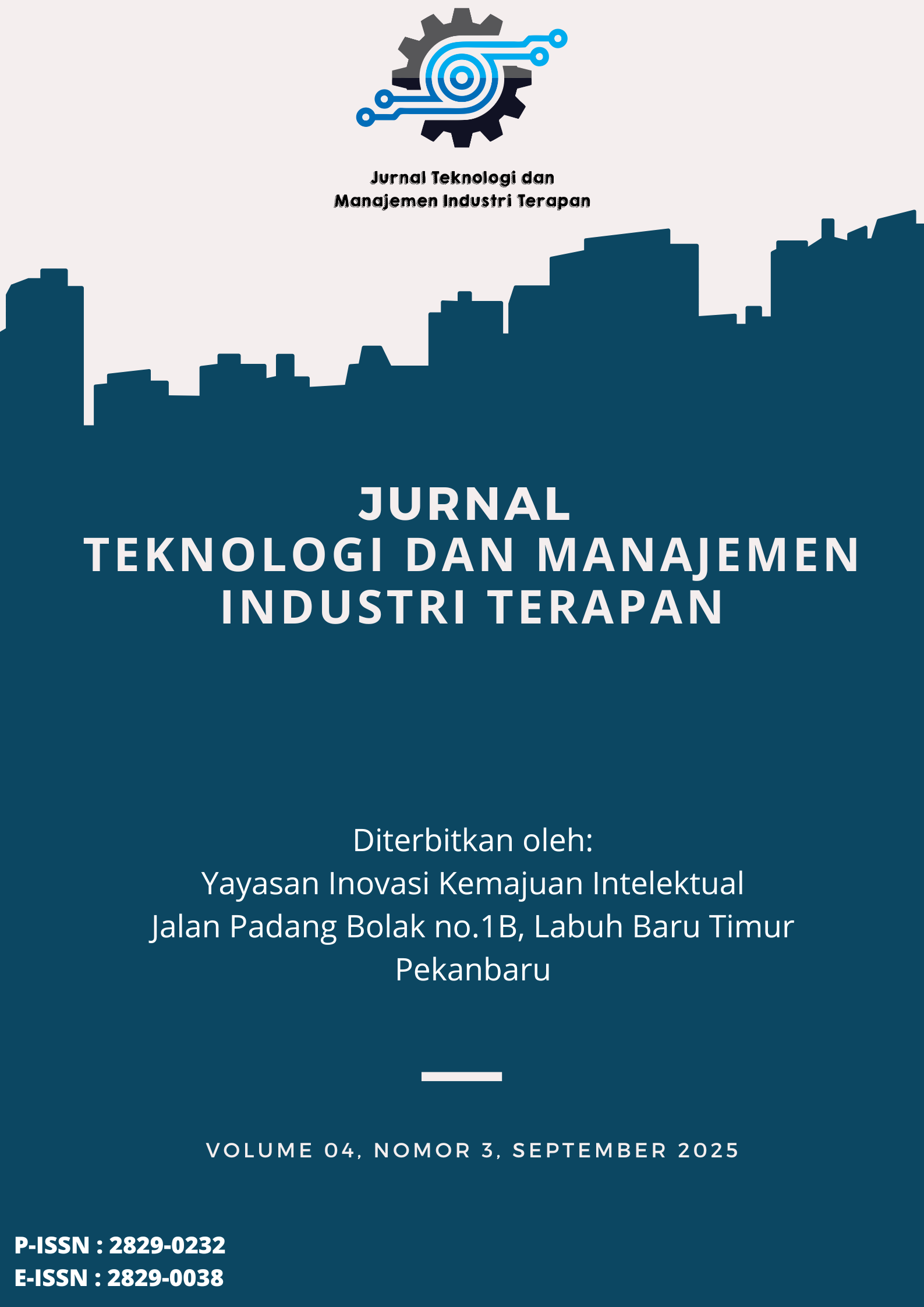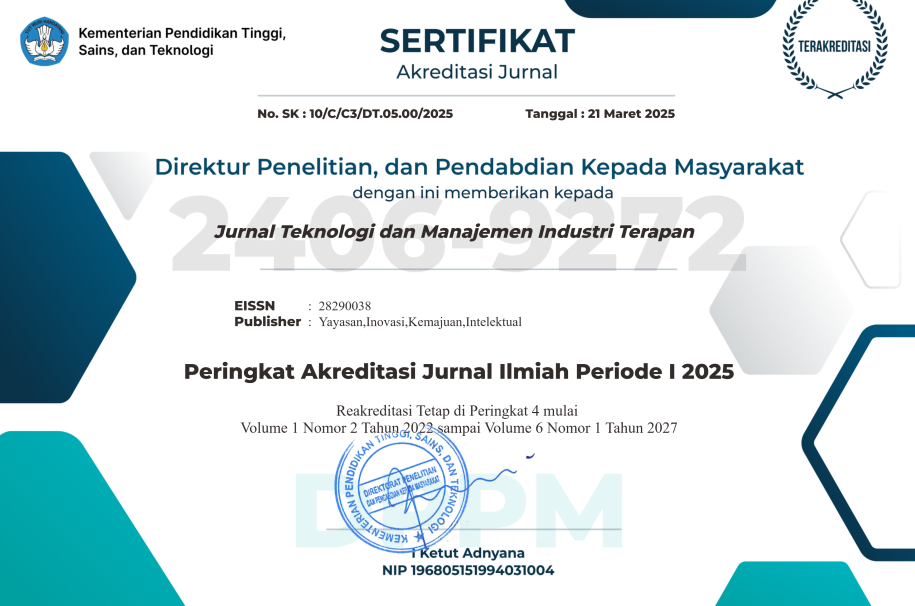Postural Risk Analysis Based on Rapid Upper Limb Assessment (RULA) Method for Manual Handling Workers in the Food Industry
DOI:
https://doi.org/10.55826/jtmit.v4i3.810Keywords:
Manual Handling, Nordic Body Map, RULA, Work Posture, ErgonomicsAbstract
Manual handling activities in the production process at PT XYZ pose a significant risk of musculoskeletal disorders due to non-ergonomic working postures. This study aims to assess postural risk levels among workers in the palletising section using the Nordic Body Map (NBM) and Rapid Upper Limb Assessment (RULA) methods. Based on responses from 15 workers, NBM results indicated an equal distribution of risk: five workers each were classified as low, moderate, and high risk. The most commonly reported areas of discomfort included the lower back, wrists, upper back, upper arms, elbows, and neck. RULA analysis yielded scores of 7 (very high risk) for lifting and placing boxes and 6 (high risk) for carrying boxes, indicating the need for immediate corrective action. These findings underscore the importance of ergonomic interventions, such as workstation redesign, ergonomic training, and assistive devices, to reduce the risk of chronic injury, improve worker well-being, and sustain productivity while minimising long-term healthcare costs.
References
D.Das, “Risk factors associated with musculoskeletal disorders among gemstone polishers in Jaipur, India,” Int. J. Occup. Saf. Ergon., vol. 27, no. 1, pp. 95–105, 2021, doi: 10.1080/10803548.2018.1511102.
K. C.Mallampalli, “Work posture and risk factors associated with work-related musculoskeletal disorders among cashew workers in Eastern India,” Int. J. Hum. Factors Ergon., vol. 8, no. 1, pp. 44–63, 2021, doi: 10.1504/IJHFE.2021.115041.
C. P.Ojukwu, “Prevalence, pattern and correlates of work-related musculoskeletal disorders among school teachers in Enugu, Nigeria,” Int. J. Occup. Saf. Ergon., vol. 27, no. 1, pp. 267–277, 2021, doi: 10.1080/10803548.2018.1495899.
L.Mateos-Gonzalez, “A systematic review of the association between job insecurity and work-related musculoskeletal disorders,” Human Factors and Ergonomics In Manufacturing. 2023. doi: 10.1002/hfm.21013.
D.Harari, “Effectiveness of a multifaceted intervention to manage musculoskeletal disorders in workers of a medium-sized company,” Int. J. Occup. Saf. Ergon., vol. 27, no. 1, pp. 247–257, 2021, doi: 10.1080/10803548.2019.1575052.
S.Yazdanirad, “Developing and validating the personal risk assessment of musculoskeletal disorders (PRAMUD) tool among steel foundry workers,” Int. J. Ind. Ergon., vol. 88, 2022, doi: 10.1016/j.ergon.2022.103276.
S. K.Zeverdegani, “Latent class-derived patterns of musculoskeletal disorders in sedentary workers and chair ergonomic design,” Int. J. Occup. Saf. Ergon., vol. 28, no. 3, pp. 1636–1641, 2022, doi: 10.1080/10803548.2021.1916239.
J.Hwang, “Evaluation of ergonomic risks for work-related musculoskeletal disorders of nursing tasks in Korea,” Int. J. Occup. Saf. Ergon., 2023, doi: 10.1080/10803548.2022.2157123.
N. S. S. A.Halim, “Effects of patient transfer devices on the risk of work-related musculoskeletal disorders: a systematic review,” Int. J. Occup. Saf. Ergon., vol. 29, no. 2, pp. 494–514, 2023, doi: 10.1080/10803548.2022.2055908.
A. A.Acquah, “Comparison of ergonomic risk factors and work-related musculoskeletal disorders among dismantler and burners of electronic waste in Agbogbloshie, Accra Ghana,” Proceedings of the Human Factors and Ergonomics Society, vol. 65, no. 1. pp. 715–719, 2021. doi: 10.1177/1071181321651256.
J. M.deSouza, “Relationship between physical activity domains and musculoskeletal disorders in public school teachers,” Int. J. Ind. Ergon., vol. 92, 2022, doi: 10.1016/j.ergon.2022.103379.
V.Weale, “Workplace musculoskeletal disorders: A systematic review and key stakeholder interviews on using comprehensive risk management approaches,” Int. J. Ind. Ergon., vol. 91, 2022, doi: 10.1016/j.ergon.2022.103338.
K.Koklonis, “Managing the Intervention Costs of Musculoskeletal Disorders in the Hospital Workplace,” IISE Trans. Occup. Ergon. Hum. Factors, vol. 9, no. 1, pp. 33–48, 2021, doi: 10.1080/24725838.2021.1985015.
M.Rasoulivalajoozi, “Prevalence of musculoskeletal disorders and postural analysis of beekeepers,” Int. J. Ind. Ergon., vol. 98, 2023, doi: 10.1016/j.ergon.2023.103504.
N. L.Black, “Different sit:stand time ratios within a 30-minute cycle change perceptions related to musculoskeletal disorders,” Appl. Ergon., vol. 99, 2022, doi: 10.1016/j.apergo.2021.103605.
E. A.Hatman, “Work-related diseases and risk factors associated with work-related musculoskeletal disorders among unionized metal industry workers: a cross-sectional study,” Int. J. Occup. Saf. Ergon., 2023, doi: 10.1080/10803548.2023.2284538.
S. T.Tolera, “Global prevalence of musculoskeletal disorders among sanitary workers: a systematic review and meta-analysis,” Int. J. Occup. Saf. Ergon., 2023, doi: 10.1080/10803548.2023.2293390.
S. M.Maduagwu, “Work-related musculoskeletal disorders among occupational drivers in Mubi, Nigeria,” Int. J. Occup. Saf. Ergon., vol. 28, no. 1, pp. 572–580, 2022, doi: 10.1080/10803548.2020.1834233.
W. K. d. S.Leite, “Risk factors for work-related musculoskeletal disorders among workers in the footwear industry: a cross-sectional study,” Int. J. Occup. Saf. Ergon., vol. 27, no. 2, pp. 393–409, 2021, doi: 10.1080/10803548.2019.1579966.
M. S.Yarandi, “The relationship between individual, physical and psychosocial risk factors with musculoskeletal disorders and related disabilities in flight security personnel,” Int. J. Occup. Saf. Ergon., vol. 28, no. 1, pp. 387–397, 2022, doi: 10.1080/10803548.2020.1760528.
D.Das, “Interactions between work-related factors, perceived fatigue and musculoskeletal disorders among handicraft artisans: structural equation model analysis,” Ergonomics, 2024, doi: 10.1080/00140139.2023.2300952.
S.Talapatra, “Assessing the impact of critical risk factors on the development of musculoskeletal disorders: a structural equation modelling approach,” Theor. Issues Ergon. Sci., 2023, doi: 10.1080/1463922X.2023.2219297.
J.Anderson, “Musculoskeletal disorders, foot health and footwear choice in occupations involving prolonged standing,” Int. J. Ind. Ergon., vol. 81, 2021, doi: 10.1016/j.ergon.2020.103079.
P.Kluay-On, “Construct validity, internal consistency and test-retest reliability of ergonomic risk assessment for musculoskeletal disorders in office workers (ERAMO),” Theor. Issues Ergon. Sci., vol. 23, no. 1, pp. 121–130, 2022, doi: 10.1080/1463922X.2021.1922780.
R.Lamontagne, “Prevention of musculoskeletal disorders among animal research technicians: Understanding difficulties and their determinants through a work activity analysis,” Appl. Ergon., vol. 103, 2022, doi: 10.1016/j.apergo.2022.103792.
M. E.Major, “Interventions for the prevention of musculoskeletal disorders in a seasonal work context: A scoping review,” Appl. Ergon., vol. 94, 2021, doi: 10.1016/j.apergo.2021.103417.
K.Huang, “Spatial relationship-aware rapid entire body fuzzy assessment method for prevention of work-related musculoskeletal disorders,” Appl. Ergon., vol. 115, 2024, doi: 10.1016/j.apergo.2023.104176.
Downloads
Published
Issue
Section
License
Copyright (c) 2025 M. Rofih, Siti Rahayu, Tri Ngudi Wiyatno

This work is licensed under a Creative Commons Attribution-NonCommercial-ShareAlike 4.0 International License.


















